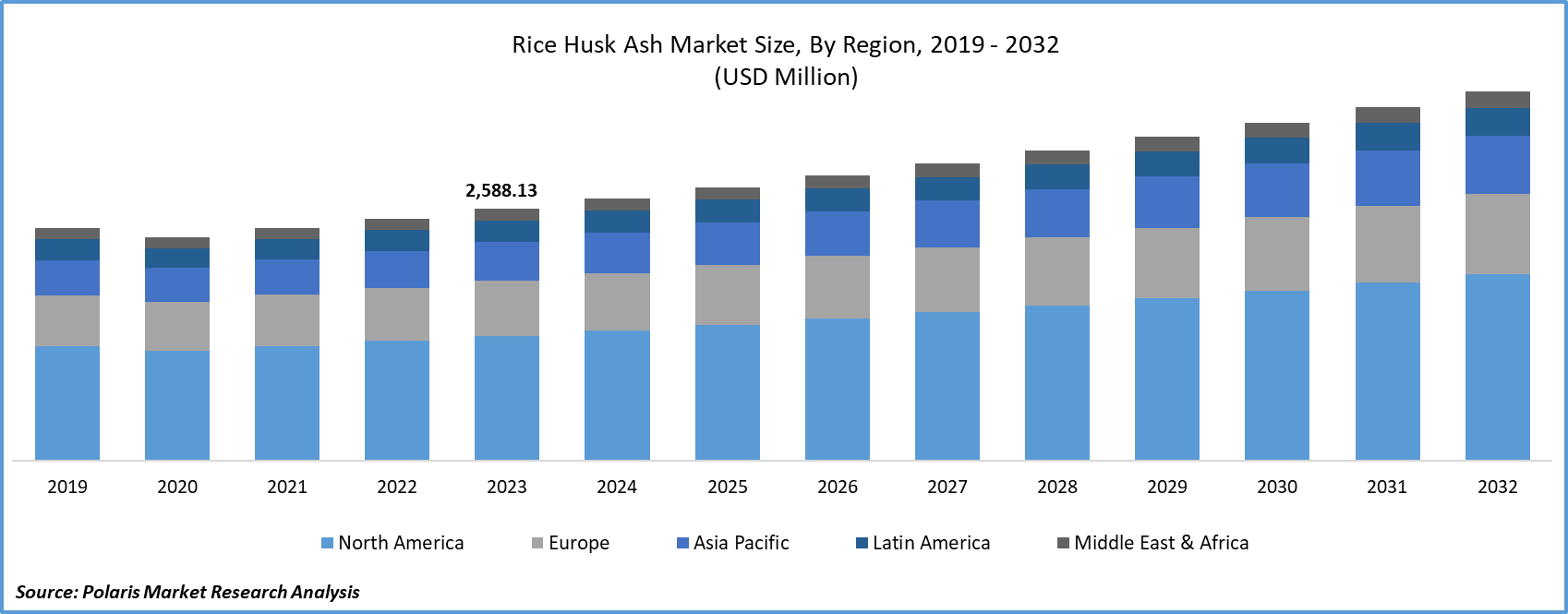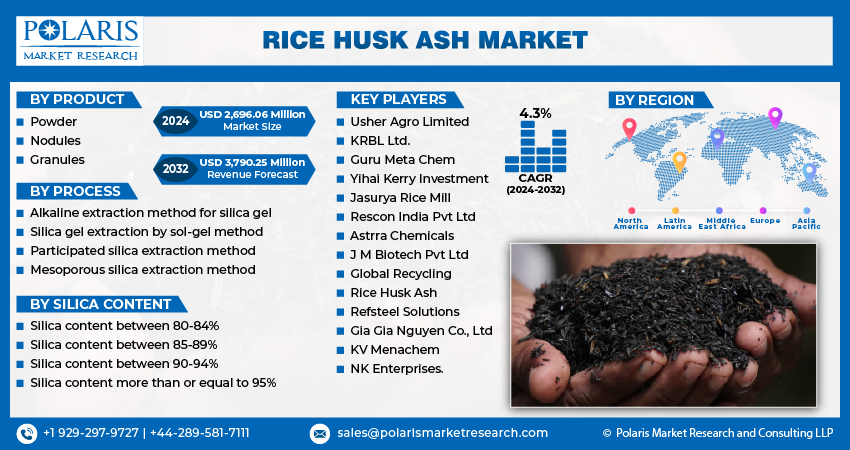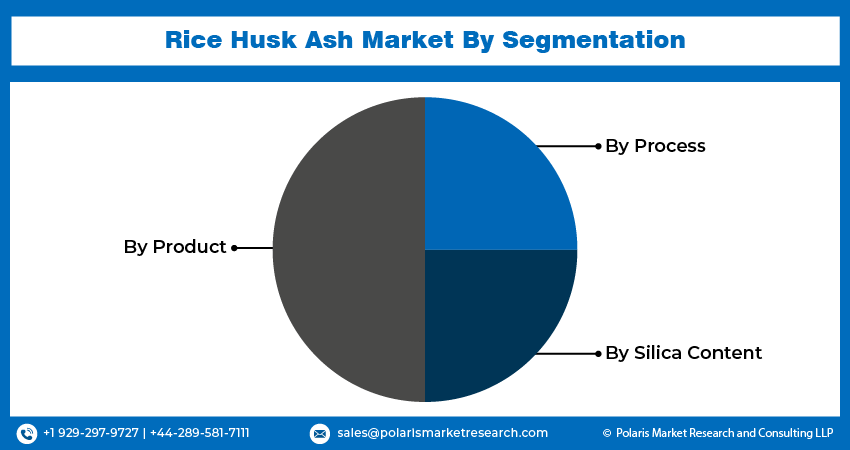
Rice Husk Ash Market Share, Size, Trends, Industry Analysis Report
By Product (Powder, Nodules, Granules); By Process; By Silica Content; Segment Forecast, 2024- 2032
- Published Date:Apr-2024
- Pages: 117
- Format: PDF
- Report ID: PM4853
- Base Year: 2023
- Historical Data: 2019-2022
Report Outlook
Global rice husk ash market size was valued at USD 2,588.13 million in 2023. The market is anticipated to grow from USD 2,696.06 million in 2024 to USD 3,790.25 million by 2032, exhibiting a CAGR of 4.3% during the forecast period
Rice Husk Ash Market Overview
Rice husk ash, acquired through the combustion of rice husk's outer layer, discarded during farming before rice consumption, emerges as a valuable eco-friendly substance. Its noteworthy potential stems from high pozzolanic reactivity and abundant non-crystalline silicon dioxide (SiO2), resembling micro silica chemically. The husks' rough texture renders them abrasive, impeding natural decomposition and complicating disposal processes.
The rising consciousness about the technical advantages of rice husk ash has significantly impacted various industries, particularly the building and construction sector. One of the primary uses of rice husk ash lies in its application as a supplementary cementitious material (SCM) in blended cement. By incorporating rice husk ash into Portland cement, certain performance aspects of the resulting blend can be enhanced. This utilization not only improves the overall quality of the cement but also contributes to sustainability efforts by reducing the need for traditional cement materials.

To Understand More About this Research: Request a Free Sample Report
Furthermore, the advantages of rice husk ash extend to its use in concrete mixtures, particularly in environments prone to marine conditions. Concrete incorporating rice husk ash exhibits superior resistance against chloride ion penetration, making it highly suitable for marine construction projects. As a result, there is a growing trend towards employing rice husk ash-based concrete mixtures in marine construction activities. Beyond construction, rice husk ash finds applications in various sectors such as waterproofing chemicals, bio-fertilizers, specialty paints, roofing materials, insecticides, and oil spill absorbents. This diverse range of applications indicates the expanding potential of the rice husk ash market across different industries.
Moreover, the rise in demand is attributed to the environmental regulations, driven by the abundant production of rice husk, an organic waste originating from the rice milling and agro-based biomass industry. Employing rice husk ash, a by-product of rice husk, across diverse industries facilitates waste reduction initiatives. Its integration into various materials and applications, including the manufacturing of refractory bricks, insulation, and flame retardant materials, plays a pivotal role in minimizing waste. Furthermore, rice husk ash is garnering recognition and support from governing bodies for its positive impact on soil acidity correction.
Consequently, the adoption of rice husk ash for diverse purposes is anticipated to offer lucrative growth opportunities in the rice husk ash market. As industries increasingly adhere to environmental regulatory norms and seek sustainable solutions, the utilization of rice husk ash presents an attractive option for waste management and resource optimization.

Rice Husk Ash Market Dynamics
Market Drivers
Rising utilization of rice husk ash in the building and construction sector bolstering the growth of the Rice Husk Ash market share.
The dominance of rice husk ash usage is evident in the construction and building sector, with its applications spanning across various functions. It in construction a pozzolan, acts as a oil adsorbent, suspension agent, filler, abrasive agent, sweeping component, additive for enamels which includes porcelain. In construction, rice husk ash finds utility as a substitute for cement, accounting for over 40% of its applications. Particularly in the industry of cement, rice husk ash's amorphous silica content is harnessed for concrete production, serving as a cost-effective alternative to Ordinary Portland cement. This utilization aids in the production of economical building blocks, particularly sought after in developing countries like Kenya and Nigeria.
Furthermore, rice husk ash contributes to the creation of highly concrete strength by substituting silica fume, a commonly used mineral admixture. It is utilized in a powdered state as an additive in concrete formulation. The increasing need for rice husk ash in construction and building sectors serves as a major force driving the expansion of the rice husk ash market.
Market Restraints
Challenges related to the disposal of rice husk ash likely to hamper the growth of the market.
The adoption of advanced technologies to manage waste, including rice husk ash and wastewater, is becoming increasingly prevalent. Some rice millers are employing rice husk ash for environmentally beneficial purposes such as soil rejuvenation and enhancing fertility. Additionally, to address disposal concerns, rice husk ash is being utilized in various applications to ensure safe management. Efforts are underway to explore commercial uses of rice husk ash more effectively and efficiently. However, improper disposal practices and inadequate facilities in many rice mills pose significant challenges that could potentially impede market growth in the forecast period.
Report Segmentation
The market is primarily segmented based on product, process, silica content, and region.
|
By Product |
By Process |
By Silica Content |
By Region |
|
|
|
|
To Understand the Scope of this Report: Speak to Analyst
Rice Husk Ash Market Segmental Analysis
By Silica Content Analysis
- The market is anticipated to witness a high CAGR during the forecast period for the range of silica content that falls between 90% and 94%. This specific range of silica content is extremely versatile and possesses beneficial properties that enhance the durability and strength of materials used in industries such as ceramics, construction, and refractories. The increasing demand for eco-friendly and sustainable alternatives across various manufacturing sectors is propelling the growth trajectory of the 90-94% silica segment of the market. The versatility of rice husk ash having elevated silica content makes it a preferred choice for multiple applications, thereby contributing to the rise in demand and expansion of this market. Considering the industries prioritizing sustainability and eco-conscious practices, the need for rice husk ash with high silica content is expected to remain strong, thereby positioning this segment as a significant growth driver in the rice husk ash market during the forecast period.
By Product Analysis
- In 2023, the nodules segment emerged as the dominant force in the rice husk ash market. This dominance can be attributed primarily to the surge in demand for nodules across various applications, including building and construction, steel production, and ceramic and refractory industries. Nodules, a specific form of rice husk ash, serve as valuable heat-insulating materials. They find extensive use for insulating molten metal in ladles and tundishes and , binding slag over liquid metal in steel mills as well as in slab casters. The unique properties of nodules make them indispensable in these applications, driving their widespread adoption and contributing to their dominance in the rice husk ash market.
- Meanwhile, the granules form accounted for the fastest segment of the rice husk ash market. Granules also offer eco-friendly properties, further bolstering the global market for rice husk ash. This environmentally sustainable attribute has played a significant role in increasing the appeal of rice husk ash in various industries. As industries continue to prioritize sustainability and seek eco-friendly alternatives, the demand for rice husk ash in granules form is expected to remain robust, contributing to the overall growth of the market.
Rice Husk Ash Market Regional Insights
The Asia Pacific region dominated the global market with the largest market share in 2023
Asia Pacific is poised to offer significant opportunities for players in the global rice husk ash market, with countries like India leading the way in the region's rapid development. The growth in Asia Pacific is driven by the remarkable progress witnessed across various nations, particularly India. Additionally, the abundance of raw materials in numerous countries, stemming from their rich agricultural heritage, is expected to further fuel the industry's growth prospects. This favorable combination of factors positions Asia Pacific as a key region for the expansion and development of the rice husk ash market.
The Middle East & Africa region is expected to experience fastest growth in its industry size, driven by continuous economic development and significant investments in infrastructure. With heavy investments pouring into the infrastructure sector, particularly in construction projects, the region is poised for significant advancements. These new development initiatives are anticipated to drive the demand for rice husk ash in the region, as it finds increasing application in various construction-related activities. As a result, the Middle East & Africa region presents lucrative opportunities for the expansion and growth of the rice husk ash market.

Competitive Landscape
In rice husk ash market, key players for market dominance through strategies like product innovation, strategic collaborations, and market expansion. Intense competition prevails, driven by factors such as product quality, pricing, and technological advancements. Companies focus on differentiation through the development of high-quality rice husk ash products tailored to meet diverse industry needs while also emphasizing sustainable practices to align with growing environmental concerns. Overall, the market is characterized by dynamism, innovation, and strategic partnerships as players seek to strengthen their market presence and capitalize on emerging opportunities.
Some of the major players operating in the global market include:
- Usher Agro Limited
- KRBL Ltd.
- Guru Meta Chem
- Yihai Kerry Investment
- Jasurya Rice Mill
- Rescon India Pvt Ltd
- Astrra Chemicals
- J M Biotech Pvt Ltd
- Global Recycling
- Rice Husk Ash
- Refsteel Solutions
- Gia Gia Nguyen Co., Ltd
- KV Menachem
- NK Enterprises.
Recent Developments
- In January 2024, Silica Power Technology Co., Ltd. introduced a fresh lineup of premium rice husk ash offerings, encompassing silica-enriched rice husk ash, amorphous rice husk ash, and calcined rice husk ash. Tailored for diverse industrial applications, these products are intended for sectors such as ceramics, glass production, and construction.
- In April 2023, Advanced Material Development was granted a U.S. patent for Liquid Phase Exfoliation, a method utilized in the production of 2D nanomaterials. Its principal application revolves around the manufacturing of graphene-based materials, including few-layer graphene and graphene nanoplatelets.
- In April 2023, Penn State University devised a swift diagnostic test for Monkeypox employing heterostructures of nanomaterials. These structures include two-dimensional hafnium disulfide nanoplatelets alongside zero-dimensional spherical gold nanoparticles.
Report Coverage
The Rice Husk Ash market report emphasizes key regions across the globe to help users better understand the product. The report also provides market insights into recent developments and trends and analyzes the technologies that are gaining traction around the globe. Furthermore, the report covers an in-depth qualitative analysis of various paradigm shifts associated with the transformation of these solutions.
The report provides a detailed analysis of the market while focusing on various key aspects such as product, process, silica content and futuristic growth opportunities.
Rice Husk Ash Market Report Scope
|
Report Attributes |
Details |
|
Market size value in 2024 |
USD 2,696.06 million |
|
Revenue Forecast in 2032 |
USD 3,790.25 million |
|
CAGR |
4.3% from 2024 – 2032 |
|
Base year |
2023 |
|
Historical data |
2019 – 2022 |
|
Forecast period |
2024 – 2032 |
|
Quantitative units |
Revenue in USD million and CAGR from 2024 to 2032 |
|
Segments Covered |
By Product, By Process, By Silica Content, By Region |
|
Regional scope |
North America, Europe, Asia Pacific, Latin America; Middle East & Africa |
|
Customization |
Report customization as per your requirements with respect to countries, regions, and segmentation. |
FAQ's
The Rice Husk Ash Market report covering key segments are product, process, silica content, and region.
The global Rice Husk Ash market size is expected to reach USD 3,790.25 million by 2032
Rice Husk Ash Market exhibiting a CAGR of 4.3% during the forecast period
Asia Pacific is leading the global market
key driving factors in Rice Husk Ash Market are rising utilization of rice husk ash in the building and construction

